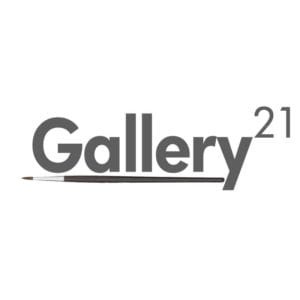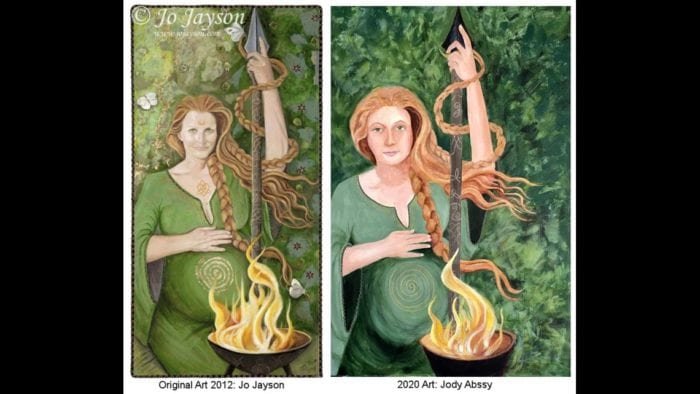Plagiarized Goddesses: Why Originality Matters

Early March was an amazing time for San Diego painter Jody Abssy. Her new exhibit, Gather Ye Goddesses, was preparing to open at Gallery 21 in the Spanish Village Art Center and was receiving very positive local news coverage including from the San Diego Union-Tribune and the local CBS affiliate.
The exhibit featured 33 paintings of both ancient and contemporary goddesses, all of them by Abssy. According to her, this was a pandemic project where she put her idle time to expand on an earlier group of 50 that she had done, using her additional research and time to expand on her earlier work.
However, just days after opening (and only halfway through the planned run) Gallery 21 pulled the plug. It was revealed that many of the paintings in the collection were near copies of earlier works. According to Rosa Ruiz, the volunteer director at the gallery, they’ve identified over half of the original artists that were copied and are still receiving additional messages via social media.
Ruiz added that all artists are required to sign a contract that states their work is original and it was because of that they closed the exhibit.
Abssy, for her part, apologized and has removed several of the paintings from her website. In a statement to CBS8, she said, “My intention was to create something original by making enough changes to call it my own. I didn’t do that. But I didn’t intentionally infringe on anyone’s copyright.”
What should have been a major moment for Abssy’s career as an artist and for her message of female empowerment, has become yet another story of a fallen artist. However, it’s a story that has several important lessons for other artists.
The Wrong Approach
In both her statement to CBS and her since-deleted post on her Facebook page (see lilnk in above CBS article), Abssy, told a similar theme: That she didn’t intend to plagiarize and but felt that she had changed enough in the works to make it her own.
However, looking at the works side-by-side, one gets the impression that Abssy attempted to re-create the original work the best she could.

While such copying can be a wonderful way to learn techniques and become a better painter, it’s generally not considered to be enough to make the work your own. It certainly shouldn’t be positioned in a gallery and presented as an original work for sale.
The topic of inspiration vs. plagiarism is a long-running one. It was one of the first topics I wrote about here nearly 16 years ago and we’ve seen it heavily discussed in other plagiarism controversies, such as the Geshin Impact one from August 2019.
However, when you’re actively recreating another work, to the point where it’s difficult to tell what was consciously changed, it’s clearly gone beyond inspiration and into copying. Though the common source material means that we would expect some similarities, this goes well beyond that.
While I’m willing to believe that Abssy didn’t intend to plagiarize, Her approach to these paintings shows a level of similarity that can only be achieved by taking a very wrongheaded approach into creating new art. After all, making an original work isn’t about “changing” what others created before you, but creating something original that is, at most, inspired by the works that came before.
Painting in a Cleanroom
Educators will likely feel that Abssy’s statements sound familiar. As if she were a student attempting to paraphrase a passage but ended up doing so by copying it and only making minor changes.
However, writing and painting are similar in that one doesn’t create an original work by making changes to an existing one. When you start mingling other people’s work with yours, even if you intend to change it, it’s far too easy to wind up with something too similar.
This is why, for students, we discuss writing in a cleanroom, a technique that fully separates one’s notes and other outside material from the writing itself.
However, this is something that can apply to other kinds of creativity, including painting. Understanding that there is a separation between preparation and creation and keeping those processes separate it can help prevent copying, accidental or intentional.
Plagiarism isn’t an accident, but neither is originality. Finding a way to speak with your voice and your creativity is part of the artistic process and it’s one of the few parts of creativity that can be taught and learned. We may not be able to make someone a great artist, but we can teach techniques and methods to make them an original artist.
This case shows why that is so fundamentally important.
Bottom Line
If we take Abssy’s statements at face value, she clearly has a fundamental misunderstanding about originality. One does not achieve originality by taking the works of others and “making them your own”. Originality is about taking in outside inspirations and influences and making something new.
It’s a subtle difference at times, but if you start with the intent to change what someone else did, you’re going to create something that is, at best, derivative.
These are important lessons for creators all ages, all stripes and all types. It’s important to not just want to create interesting works, but to create original ones.
Otherwise, as Abssy found out, all the work, research and effort that you did put in will go to waste and, unfortunately, what people will remember is not your message but the plagiarism.
It’s something that can be easily avoided, but only with the right tools and right approach.
Header Image: Photo from CBS8, Content from Selma Fenech (Left) and Jody Abssy (Right)
Want to Reuse or Republish this Content?
If you want to feature this article in your site, classroom or elsewhere, just let us know! We usually grant permission within 24 hours.
